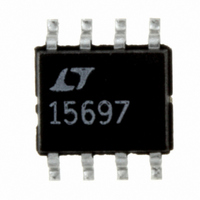LTC1569CS8-7#PBF Linear Technology, LTC1569CS8-7#PBF Datasheet - Page 8

LTC1569CS8-7#PBF
Manufacturer Part Number
LTC1569CS8-7#PBF
Description
IC FILTER 10TH ORDR LOWPASS8SOIC
Manufacturer
Linear Technology
Datasheet
1.LTC1569CS8-7PBF.pdf
(12 pages)
Specifications of LTC1569CS8-7#PBF
Filter Type
Linear Phase, Lowpass Switched Capacitor
Frequency - Cutoff Or Center
300kHz
Number Of Filters
1
Max-order
10th
Mounting Type
Surface Mount
Package / Case
8-SOIC (3.9mm Width)
Lead Free Status / RoHS Status
Lead free / RoHS Compliant
Voltage - Supply
-
Available stocks
Company
Part Number
Manufacturer
Quantity
Price
APPLICATIONS
LTC1569-7
The oscillator is sensitive to transients on the positive
supply. The IC should be soldered to the PC board and the
PCB layout should include a 1 F ceramic capacitor be-
tween V
the IC to minimize inductance. Avoid parasitic capacitance
on R
a ground plane connected to V
applications. Connect a ground plane to GND (Pin 3) for
dual supply applications and connect V
copper trace with low thermal resistance.
Input and Output Range
The input signal range includes the full power supply
range. The output voltage range is typically (V
to (V
peak-to-peak signal swing of the filter, the GND (Pin 3)
voltage should be set to 2V (1.11V) in single 5V (3V)
supply applications.
The LTC1569-7 can be driven with a single-ended or
differential signal. When driven differentially, the voltage
between IN
gain of 1. The single-ended output voltage OUT (Pin 8) is
referenced to the voltage of the GND (Pin 3). The common
mode voltage of IN
the input signals within the power supply range.
For noninverting single-ended applications, connect IN
to GND or to a quiet DC reference voltage and apply the
input signal to IN
gain from IN
OUT are referenced to the same voltage, i.e., GND, V
some other DC reference. To achieve the distortion levels
shown in the Typical Performance Characteristics the
8
X
i =
+
and avoid routing noisy signals near R
– 0.8V) when V
IN
GND
IN
IN
+
+
125k
–
– GND
+
(Pin 7) and V
2
1
3
+
+
and IN
to OUT will be 1. This is true given IN
125k
+
. If the input is DC coupled then the DC
+
U
+
–
–
and IN
(Pin 1 and Pin 2) is filtered with a DC
–
+
S
= 3V. To maximize the undistorted
–
125k
INFORMATION
Figure 8
(Pin 4) , as close as possible to
U
–
can be any voltage that keeps
–
(Pin 4) for single supply
W
–
X
(Pin 4) to a
(Pin 6). Use
–
U
8
1569-7 F08
+ 50mV)
OUT
+
and
–
or
–
input signal at IN
voltage at IN
in the Typical Applications section.
For inverting single-ended filtering, connect IN
to quiet DC reference voltage. Apply the signal to IN
DC gain from IN
to IN
Refer to the Typical Performance Characteristics section
to estimate the THD for a given input level.
Dynamic Input Impedance
The unique input sampling structure of the LTC1569-7 has
a dynamic input impedance which depends on the con-
figuration, i.e., differential or single-ended, and the clock
frequency. The equivalent circuit in Figure 8 illustrates the
input impedance when the cutoff frequency is 128kHz. For
other cutoff frequencies replace the 125k value with
125k • (128kHz/f
When driven with a single-ended signal into IN
tied to GND, the input impedance is very high (~10M ).
When driven with a single-ended signal into IN
tied to GND, the input impedance is a 125k resistor to GND.
When driven with a complementary signal whose com-
mon mode voltage is GND, the IN
125k to GND and the IN
GND. To make the effective IN
driven differentially, place a 62.5k resistor from IN
GND. For other cutoff frequencies use 62.5k • (128kHz/
f
typical variation in dynamic input impedance for a given
clock frequency is 10%.
Wideband Noise
The wideband noise of the filter is the RMS value of the
device’s output noise spectral density. The wideband
noise data is used to determine the operating signal-to-
noise at a given distortion level. The wideband noise is
nearly independent of the value of the clock frequency and
excludes the clock feedthrough. Most of the wideband
noise is concentrated in the filter passband and cannot be
removed with post filtering (Table 2). Table 3 lists the
typical wideband noise for each supply.
CUTOFF
+
and OUT is reference to GND.
), as shown in the Typical Applications section. The
–
. The input can also be AC coupled, as shown
–
CUTOFF
to OUT is –1, assuming IN
+
should be centered around the DC
).
–
input appears to have –125k to
–
+
impedance 125k when
input appears to have
–
is referenced
+
–
+
to GND or
with IN
with IN
–
. The
–
to
+
–















